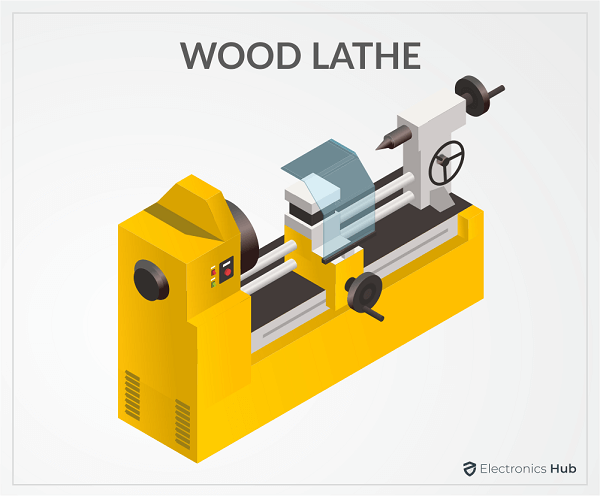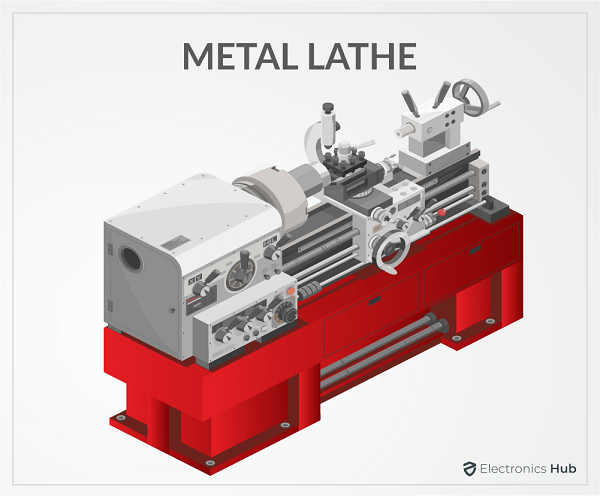Confused about the basics of wood lathe and metal lathe? There’s no doubt that a lathe machine is one of the most important aspects of both woodworking and metalworking. In the case of wood, the sky’s the limit, you can convert any woodwork into the desired results. The metal too can be easily modified with this.
Let us have a deeper look at what these machines are. And which will be the best fit for you, if you’re looking to have one.
Outline
ToggleWhat Is a Wood Lathe?
As the name suggests, the wood lathe is meant to carve the desired woodwork from a raw wooden log or irregular-shaped wood. The project ideas with a wood lathe are almost limitless. You can cut, sand, drill, turn and even deform the workplace according to your will.
There are various models available in the market. Each of them satisfies different needs. Some are perfect for heavy workloads while some are suitable to start a new hobby. If not specifically decided, you should consider a benchtop wood lathe. They can be easily placed on your workshop table and are perfect for individual usage.
Although, the wood lathe does have some power limitations. They’re only meant to work on woods only, using them against hard materials such as metal will not be a wise decision.
Advantages
- They’re simple to use and even beginners can start trying them.
- Many models are relevant for individual purposes.
- The effective pulley system allows easy rotation control
- You can easily carry some models such as bench top wood lathes.
- They’re comparative light weighted
Disadvantages
- The rotation speed is far lower than the metal lathe
- You shouldn’t use a wood lathe for metals and other heavy materials.
What Is a Metal Lathe?
Similarly, the metal lathe is mostly used for metalwork. However, the power capacity increases here tremendously. The rotation power of the metal lathe allows you to play with any metal workpiece without much hassle. In general models, the complete lathe process is done by programmed automation. The only thing you need to do is configure it according to your needs.
The common materials used here are aluminium, high-grade steel, and other heavy metals as well. However, here’s the advantage of having a powerful rotation. You can also process woodworking here. With the lathe’s precise rotating speed, there aren’t any specific limitations or drawbacks.
Advantages
- The best machine to deform metals at your will
- The rotation is more powerful
- It is built sturdy and doesn’t require much care.
- The work is done with the help of automation. Thus, leading to precise cutting.
Disadvantages
- The working mechanism is complex
- Not advisable for beginners.
Comparison: One on One
So far, you should’ve got the bigger picture. However, the winner hasn’t decided yet. Further, we’ll compare these lathes based on different situations and needs. This will help you to make a better decision and a satisfying lathing experience.
Applications
Starting with the most obvious difference, its applications. The applications of these lathe machines are different- wood lathe for wood and metal lathe for metal work. Moving further to the detail.
There are numerous applications you can perform with a wood lathe. Sanding, deforming, turning, drilling combine makes you a powerful craftsman here. But, these wood lathes come with limited capabilities in terms of power. You can’t use metal or other hard materials other than wood here.
On the other hand, the metal lathe is the most flexible one. You can use them to carve both of the materials, whether it’s metal or timber wood. Here too, the sky’s the limit. A metal lathe allows you to carve industrial tools or imagination out of heavy metals such as steel or aluminium. You can completely rely on its powerful rotation, that can be anything.
Keep in mind, the powerful ability of metal lathe allows many professionals to use it with wood as well.
Cost
The budget margin of these lathe machines is quite obvious. Being the most powerful, the metal lathe demands some high price to work with it.
The wooden lathe, on the flip side, doesn’t require that much investment. It is advisable to consider only wooden lathes if you only deal with wooden works. A small investment of $300 will give you a satisfactory wood lathe experience.
Physical Features
You can easily observe some notable differences by simply having a glance at these lathe machines. The wood lathe is so light weighted (benchtop model), that you can easily place it on the bench of your workshop. Thus, you will not have to think about the area twice before using it.
A metal lathe is a kind of bulky machine. They’re heavy and require enough free space for a smooth working experience. Before buying, make sure you have a separate professional workshop to use a metal lathe.
Moreover, unlike wood lathes, the metal lathe uses many complex working components. This is why a beginner can try to use a wood lathe but should be experienced in the case of a metal one.
Portability
Considering the portability factor is one of the wise decisions while buying a lathe machine. You might need to transport or shift it to other destinations. In such a situation, an easy transportation process can make your day.
In the case of the wood lathe, it depends on the type of model you’re focusing on. Taking a benchtop as an example, you can easily carry it along with you. However, it will require some human force, but not as an uphill battle.
The metal lathe is more suitable for stationary purposes. To provide you with more powerful rotations, other non-mandatory factors are okay to compromise.
The Way you use
This is another main difference to look for in a wood lathe and metal lathe. Their working metals are like different shores of the sea. In the wood lathe, you’ll be required to work manually. There is barely any automation, even in higher models. You’ll have to devote constant direction to work with it.
The metal lathe is more of an automation side. Their work consists of several programming components. Here, you’ll not have to worry about speed or turning angle.
Accuracy
There’s no doubt that the metal lathe is more accurate and precise with results. The reason behind this is their computerized programs, you only need to configure it according to your needs. Whereas, the wood lathe requires more concentration during work. There are more chances that you’ll commit some mistakes here.
Potential Threats
All the types of machinery do have some potential to cause damage to our health. And the same goes with these lathe machines. Let’s discuss both of them individually for clarification
Indeed, the rotation of the wood lathe is slower than the metal lathe, but it can still harm you. Always pay attention that you’re not too close to the moving wood piece. Also, the wood dust coming from the project is not a joke to your eyes. Wear proper transparent specs for utmost eyes protection.
The metal lathe is more dangerous as compared to the wood one. The reason is simple, its powerful rotation and the raw material you’re using (hard metal). Needless to say, the metal particles or spark might even turn you completely blind. Not only this, the noise production is oftentimes unbearable.
Conclusion
I hope this short guide has cleared your every doubt related to the wood lathe and metal lathe. Now, the main question arises, should you consider a metal lathe for woodwork? If you are someone who deals with both wood and metal works, buying a metal lathe will save you a tonne of money.
However, settle with the wood lathe, if you want some detailed craftsmanship into your projects. The smaller the wood lathe the better it would be for detailing.



